💦 The impacts of transport systems on freshwater resources 🚊
💦 The impacts of transport systems on freshwater resources 🚊
Futura-Mobility‘s mission is to imagine and share the changes mobility must make by 2050 to respect planetary boundaries and increase societal benefits.
In 2025, the think tank decided to explore the impacts and role of mobility with regards two boundaries in particular: biodiversity loss and freshwater withdrawal. With experts from the fields of energy, transport and geology, this session on 5 September 2025 was an opportunity to examine four key questions on freshwater use by transport systems.
When preparing the session, it became clear that this topic garners less attention than decarbonisation. “Yet freshwater withdrawal is indeed one of the planetary boundaries: exceeding it makes life on Earth more difficult, even impossible in some places, and disrupts the entire Earth system. Not only human life, but also that of non-humans, including plants, animals, fungi, bacteria…,” explains Joëlle Touré, general delegate of the think tank, in her introduction.
❓ Why worry about the Earth’s freshwater resources, since water does not disappear but is constantly moving around the water cycle?
On Earth, 97.5% of water is salt water. This means that only 2.5% is freshwater, 69% of which is stored in ice and 30% in aquifers. Only 1% of this 2.5% is ‘free’ and found mainly in large lakes, marshes, and rivers.
The freshwater withdrawal boundary has two sub-boundaries:
– blue water, which comes from precipitation and is found in lakes, groundwater, or flowing in rivers;
– green water, which is water useful to plants: this is so-called ‘effective’ precipitation and water stored in the soil by organic matter. It is water useful for crops, trees, and vegetation in general. Green water is also essential for water circulation in the atmosphere thanks to this storage and evapotranspiration.
The boundaries are ‘exceeded’ when the proportion of the Earth’s surface area on which river flow (for blue water) and soil moisture (for green water) diverted from their natural cycle by human activities exceeds the upper value of this deviation in the pre-industrial era (1661-1860). In 2024, in an article published in the scientific journal Nature Water, researchers from Finnish and Swedish institutes estimated that more than 18% of land area for blue water and nearly 16% for green water is experiencing a deviation from the natural cycle, compared to limits set at 10% and 11% respectively.
Freshwater withdrawal was the sixth of the nine planetary boundaries to be breached. Since these boundaries are interconnected, exceeding one increases the risk to others, with a cascade effect.
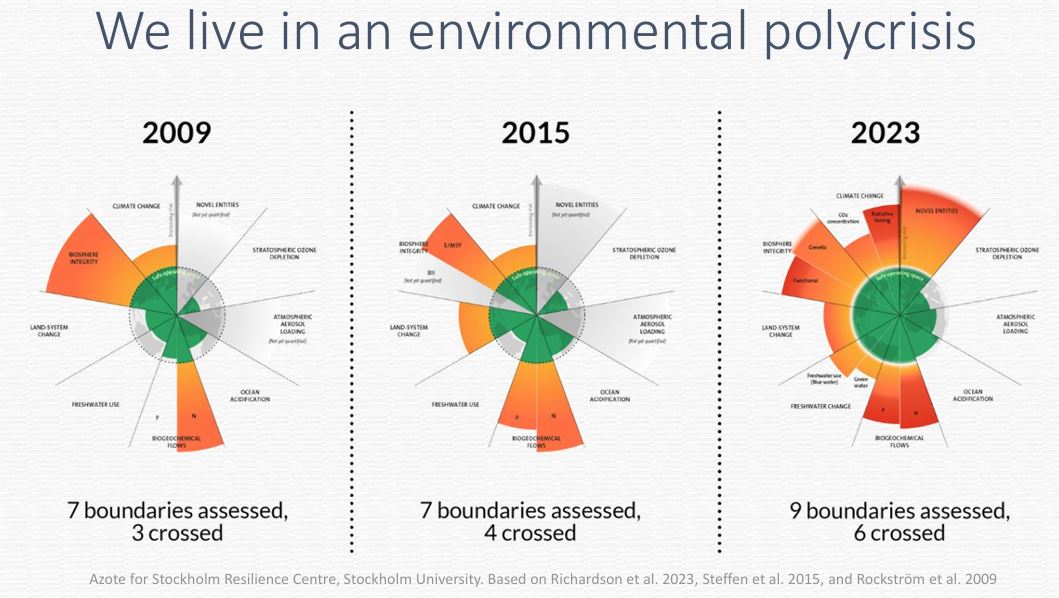
“Although greenhouse gas (GHG) emissions have attracted and continue to attract much attention, other boundaries, like freshwater use, are also being exceeded,” says André Stephan, associate professor of Construction and Environmental Performance at The University of Melbourne.
The world is facing an increasingly serious freshwater crisis, with around half of the global population experiencing severe water shortages for at least one month of the year. This situation is exacerbated by climate change, which is leading to more erratic water flow and resulting in more droughts and floods.
Water is a resource that needs to be analysed locally, since water-related, environmental damage is localised, unlike greenhouse gas emissions, which have a global impact. “While global assessments of water scarcity can provide a general picture, more localised assessments are needed,” explains professor Stephan.
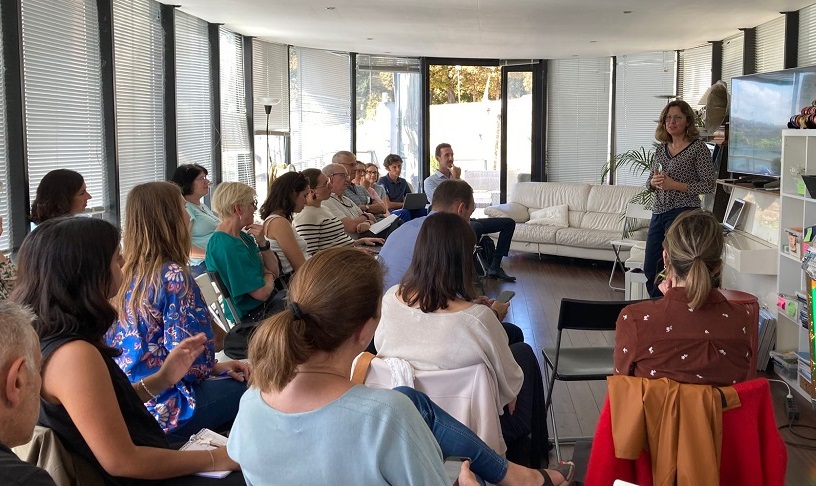
❓ In the context of climate change, to what extent will freshwater resources become less available?
Simon Ferrière, Energy & Climate project manager at the French High Commission for Strategy and Planning, presented insightful work on the subject, including the key findings of the major prospective study L’eau en 2050 : graves tensions sur les écosystèmes et les usages, published in June 2025.

The first part of the study presents an overview of water consumption by use in France. Mainland France records 500 billion cubic metres of water annually in the form of precipitation. Approximately 60% (300 billion cubic metres) is captured by nature, evaporated by the soil or absorbed and transpired by plants – an “absolutely vital” phenomenon for wetlands and forests, insists Mr Ferrière. The remaining 40%, or 200 billion cubic metres, is renewable water – blue water – which flows into rivers or seeps into groundwater, and used both by ecosystems and for human activities (energy, industry, drinking water, etc).
“When we think about water, we must remember it is vital for aquatic ecosystems,” explains Mr Ferrière. “So we should start by asking ourselves – are we meeting environmental needs? – before questioning whether we have enough water for our human activities,” he expands. “This approach goes against our tendency to prioritise human needs.”
With regards human activities, differentiating between withdrawal, discharge and consumption is another must. Withdrawal refers to pumping water from a watercourse or groundwater for human needs; discharge is the portion of withdrawal that is treated then returned to a watercourse after our use, i.e. returned to the environment; consumption is the portion of withdrawal that evaporates or is no longer available to ecosystems, so not returned to the environment. “These three concepts are important because they have different impacts on the availability of freshwater resources,” adds Mr Ferrière.
The main conclusions of this first part of the study highlight how the energy sector withdraws the most freshwater in mainland France, especially because of its nuclear power plants, and agriculture is the sector that consumes the most freshwater, because of irrigation. These two findings obviously raise questions about developing biofuels, which are certainly a less carbon-intensive source of energy, but also more water intensive.
The second part of the study presents a forward-looking assessment of the hydrological situation in France. The authors divided the country into 40 watersheds based on hydrological criteria, rather than administrative boundaries. They then studied each basin individually to determine the number of months in 2050 when environmental needs would not be met (with a focus on aquatic ecosystems). “We ran two tests, one based on a particularly dry year in 2050 and the other on a particularly wet year in 2050,” explains Mr Ferrière.
The results reveal that in 2050, the environmental needs of a great many of these 40 watersheds will not be met for several months, even without any human activity involving water withdrawal or consumption. This finding will worsen considerably in dry years, when the situation, which will be “catastrophic everywhere”, will lead to severe degradation of ecosystems. Surprisingly, the study shows that even in wet years, ecosystems in certain areas will be ‘under stress’ , especially in the south of France. The main cause of this degradation? Climate change directly linked to human activity.
The third part of the study examines changes in water use by humans in these same 40 watersheds, through three scenarios for 2050:
- The Trend scenario projects water use based on historical trends for the years 2010-2020. In this scenario, decarbonisation has not been reached, and the French have kept more or less to the same diets as today.
- The Public Policies scenario incorporates all current French public policies, like the National Low-Carbon Strategy (SNBC), which aims for carbon neutrality by 2050, as well reviving nuclear power.
- The Disruption scenario puts the emphasis on strong sobriety measures. Inspired by scenario 2 of the French Agency for Ecological Transition (ADEME), it envisages a significant reduction in energy consumption, a decrease in travel, and highly plant-based diets.
Projections show severe tension over access to water in all three scenarios, even with the sobriety measures in the Disruption scenario. The link between withdrawals and available resources reaches critical thresholds (sometimes over 100%) in the Trend scenario, but could be better managed in the Disruption scenario.
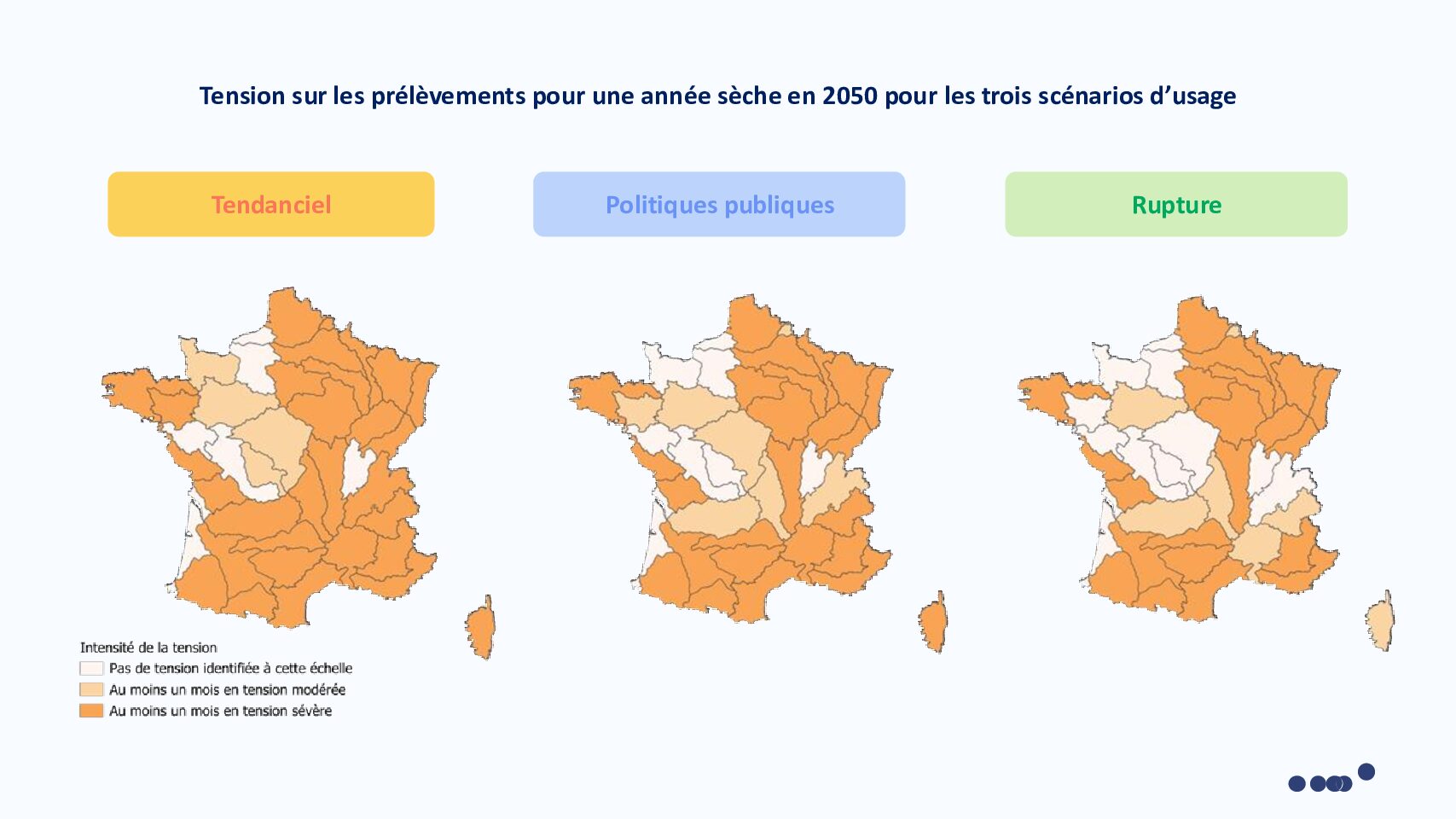
While total withdrawals nationwide could decrease in the future in the Public Policies and Disruption scenarios (mainly down to renovated nuclear power plants on the Rhône), the situation is more complex at local level, with some watersheds still experiencing an increase in withdrawals.
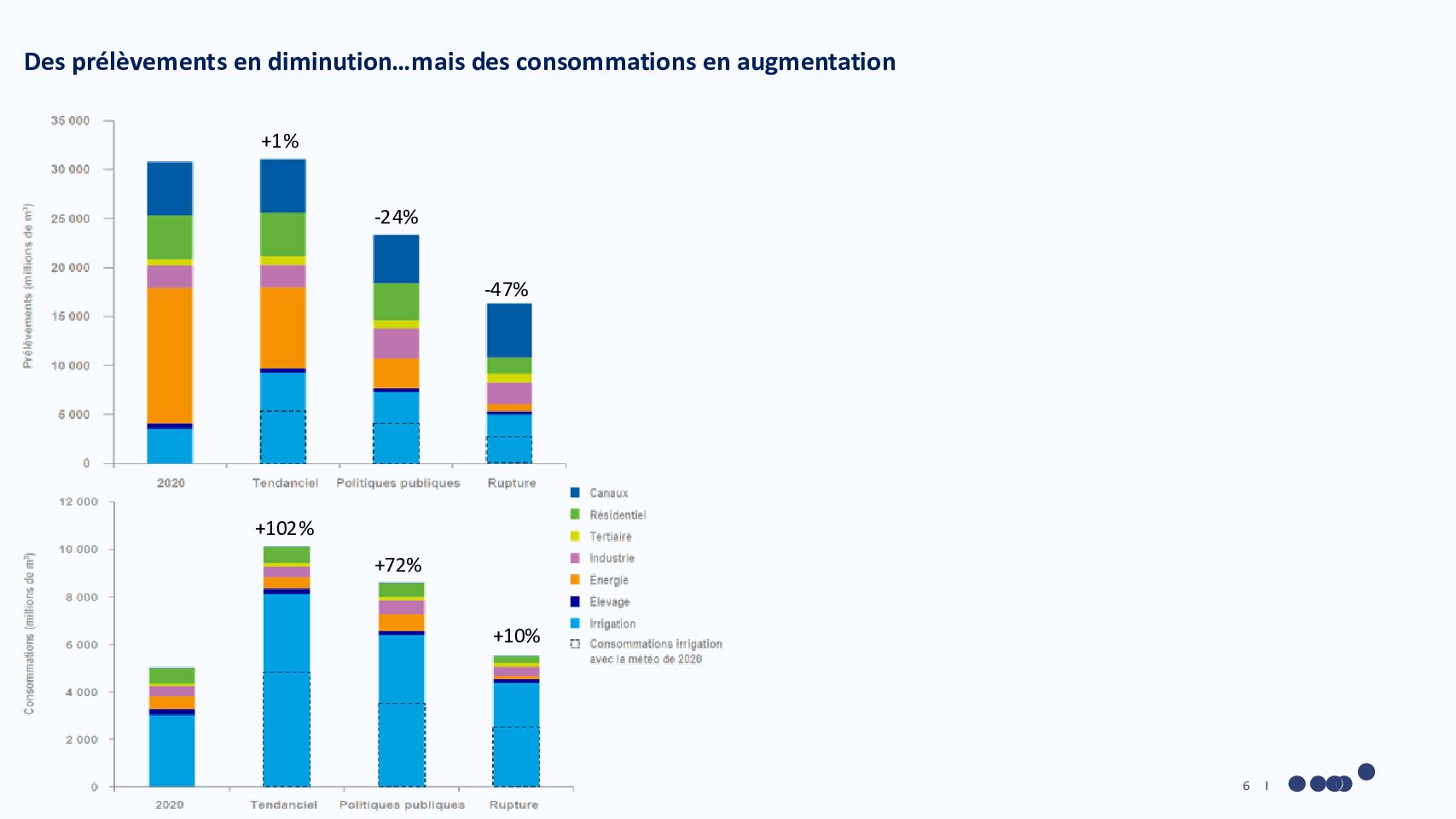
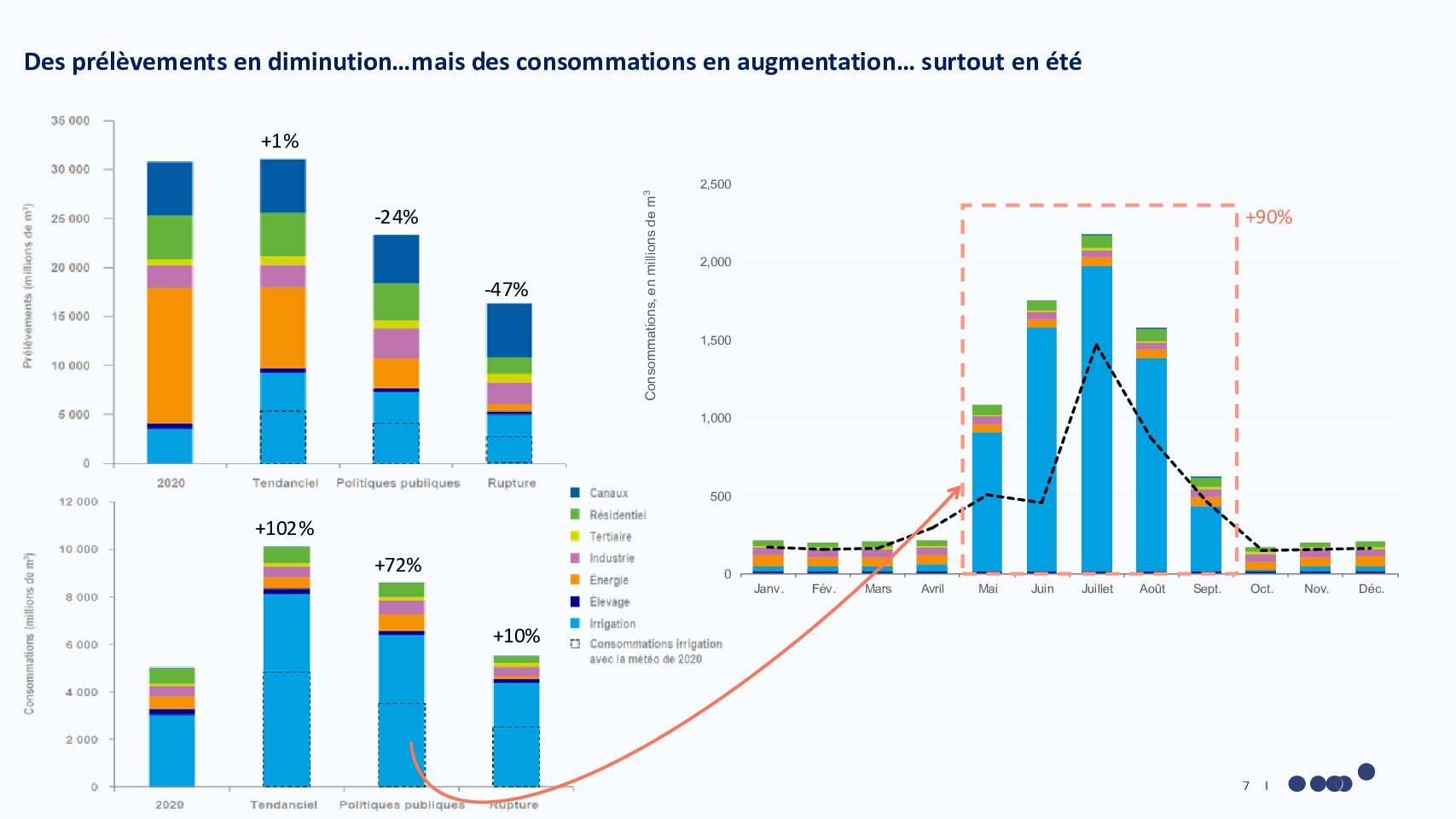
On the other hand, water consumption increases in all scenarios, even doubling in the Trend scenario. This rise is mainly due to farming irrigation, which grows in all scenarios. Agriculture uses large volumes of water, most of which is consumed because absorbed then transpired by plants or evaporated from the soil. Climate change is exacerbating this phenomenon with temperatures on the rise and rainfall decreasing. In addition, 90% of this agricultural consumption is concentrated between May and September, a period when water resources are already at their scarcest, and set to become even more so in the future.
By 2030, the French government plans to upgrade nuclear power plants currently operating with open-cycle cooling systems, which tend to withdraw a lot of water but consume little. Here the study points out a blind spot in the data: ‘due to the higher temperature of the discharge water, there is an additional phenomenon of forced evaporation, estimated in the Rhône valley at 0.8% of the volume discharged. This data is overlooked in current statistics, which consider the consumption of open-cycle power plants to be zero.’
Equipping them with closed-loop cooling systems will reduce water withdrawals but increase water consumption!
The conclusions of the study stress the importance of alerting public decision-makers to the risks of severe water stress and of preparing regions for resilience. France is already experiencing the very real consequences of droughts, even in regions that have traditionally always had plenty of water, like the Massif Central. In 2022, 700 municipalities had no access to drinking water because of drought.
“When developing public policies, including for decarbonisation, we can’t ignore the issue of water,” warns Mr Ferrière. Indeed, any decarbonisation strategy, including for transport, should be designed with the availability of water resources and their impact on ecosystems and biodiversity in mind. “Measures to reduce consumption, such as reducing travel as mentioned in the Disruption scenario, can contribute to overall decarbonisation and indirectly to preserving water resources, thereby benefiting ecosystems.”
Ultimately, the issue of water is intrinsically linked to the societal choices we make, especially in terms of food and the energy mix. “Can the society envisaged in these scenarios be viable with the water resources that will be available in 2050? We need to think about this,” concludes Mr Ferrière.
❓ What responsibility does transport have for freshwater resources?
According to André Stephan, who presented his research on water and transport in Melbourne, water use in transport is rarely analysed, probably because it is “quite invisible and hidden” compared to greenhouse gas emissions (GHG) emissions, which are easier to assess. However, adopting a life cycle assessment (LCA) perspective reveals all the environmental flows involved in manufacturing vehicles, operating trams and trains, producing the electricity that powers them, as well as maintaining, insuring, marketing, and replacing transport infrastructure components.
The study Total water requirements of passenger transport modes (2016, André Stephan and Robert H. Crawford) set out to quantify the total water requirements of the main modes of urban passenger transport (cars, trains, metro systems, and trams). It provides water use intensities per passenger kilometre to inform decision-making and improve the environmental performance of the sector.
Professors Stephan and Crawford used 2012 data from Transport Victoria, including Melbourne’s electric metro and tram network. “We obtained fairly detailed reports on operators’ financial expenditure, as well as the total number of passenger-kilometres travelled for these modes of transport.” They then combined this data with water intensity data for expenditure segments (infrastructure, administration, operations, fuel, insurance, tyres, etc), based on macroeconomic ‘input-output’ data, to estimate the amount of water used and, knowing the passenger-kilometres, calculate the average water use per passenger-kilometre.
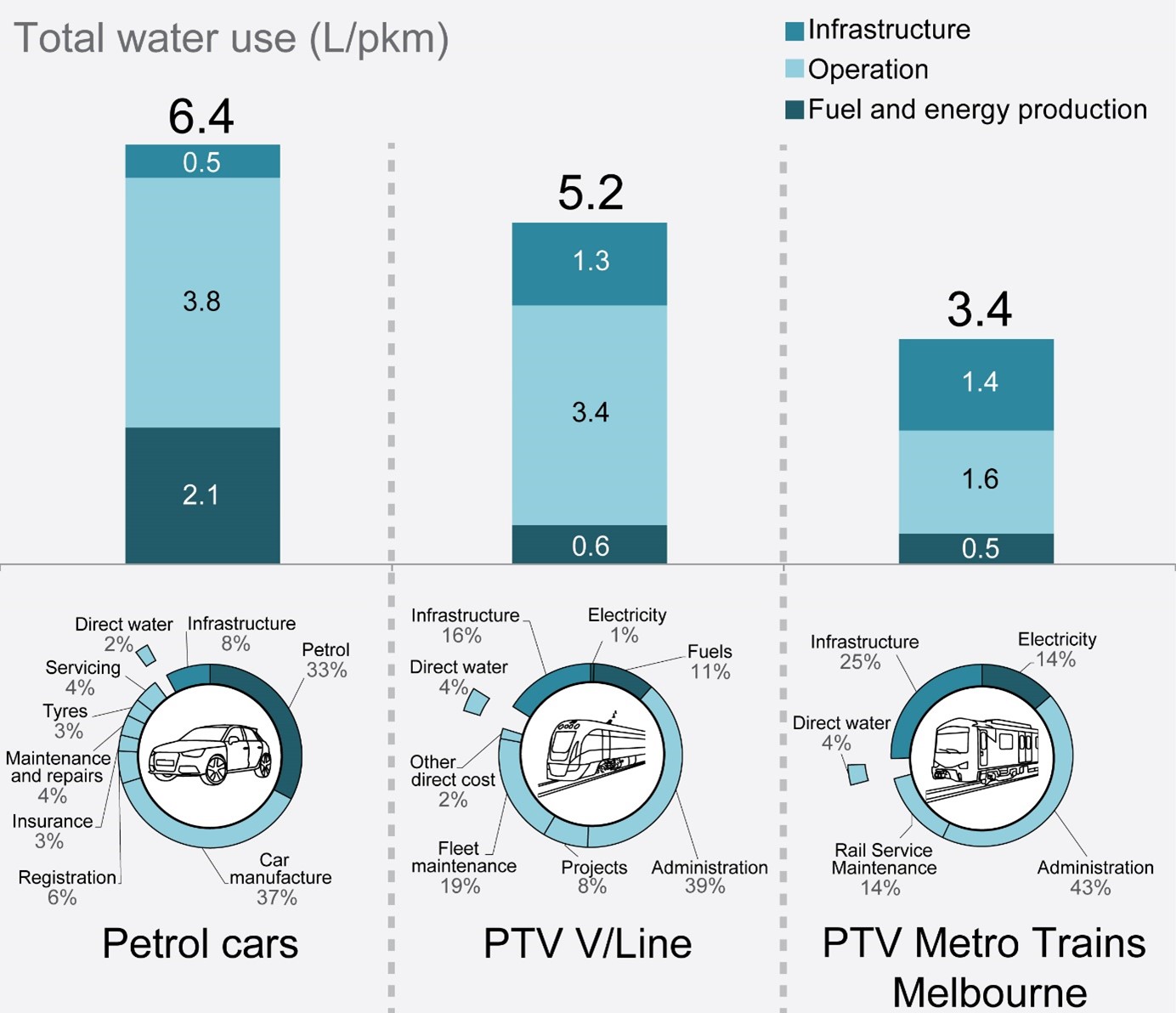
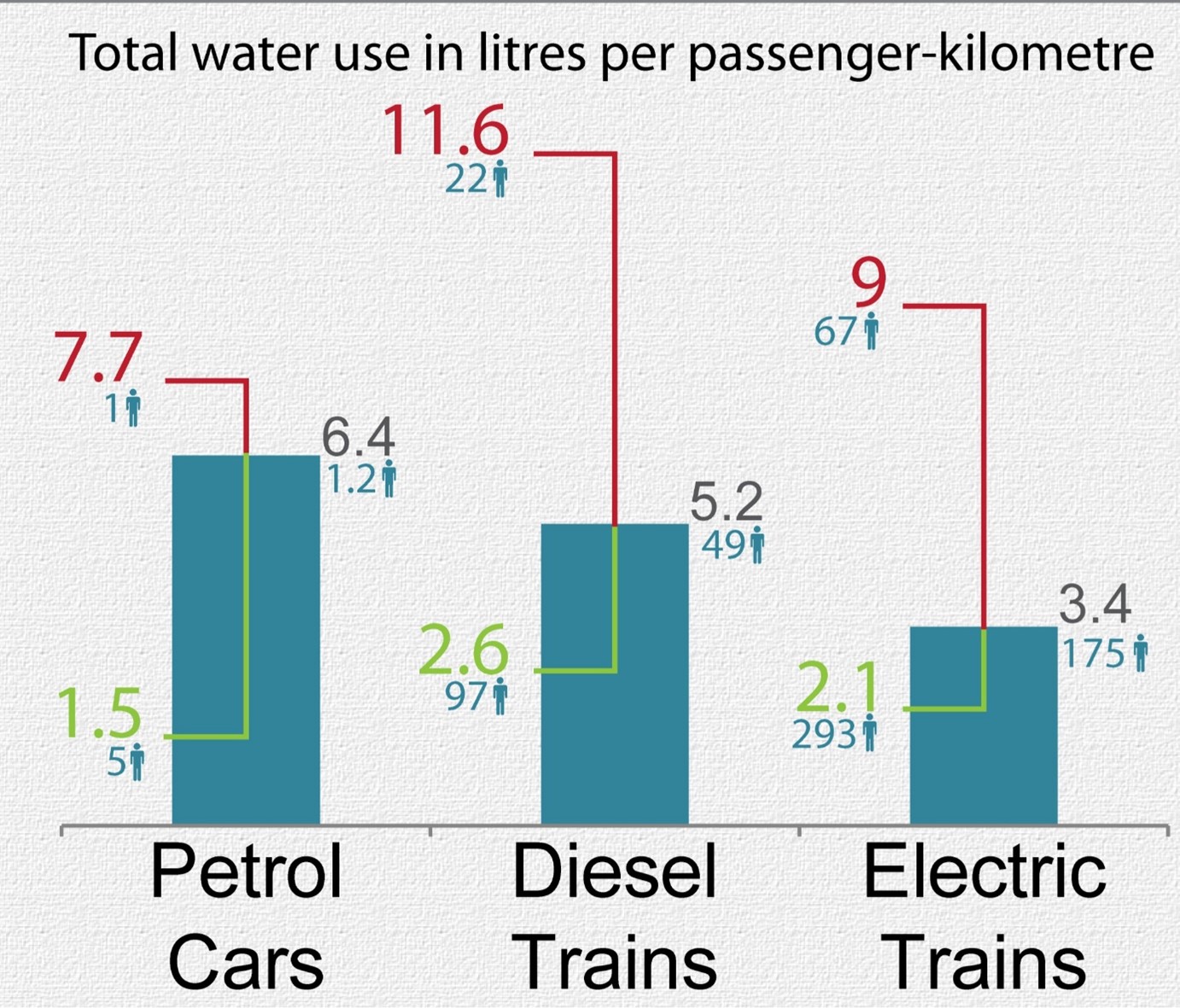
The study shows that petrol cars are the most water-intensive mode of transport. They consume around 6.4 litres of water per passenger-kilometre, based on an average occupancy of 1.2 people per car.
If a person makes a daily round trip of 25 kilometres (50km a day) alone in a car, this represents a need for 320 litres of water a day: the equivalent to approximately two months of drinking water for one person. In comparison, taking a train carrying 175 passengers significantly reduces the individual water footprint.
These figures highlight huge room for improvement. Public transport and active modes of transport offer substantial savings in indirect water use, especially in terms of infrastructure management, while also reducing energy consumption and GHG emissions.
“Giving up the car is a lifestyle choice that goes beyond simply reducing the transport water footprint,” points out professor Stephan. “Car ownership encourages us to consume more (more journeys, more purchases), and these consumption activities increase GHG emissions and have other impacts on the environment.”
The research by professors Stephan and Crawford underscores the need to preserve our planet through informed, environmental LCAs based on transport data . “Life cycle analysis is essential, because focusing solely on tailpipe emissions, as has been the case for decades, is not enough for water,” concludes professor Stephan. ‘To integrate water into the environmental agenda of decision-makers, the supply chain must be mapped and water consumption hotspots identified.”
Energy, water and transport
The transport sector plays a leading role in energy demand and can do much to reduce related water use. Although agriculture withdraws and consumes the lion’s share of freshwater worldwide, the energy sector accounts for a considerable 10 to 15% of global freshwater withdrawals.
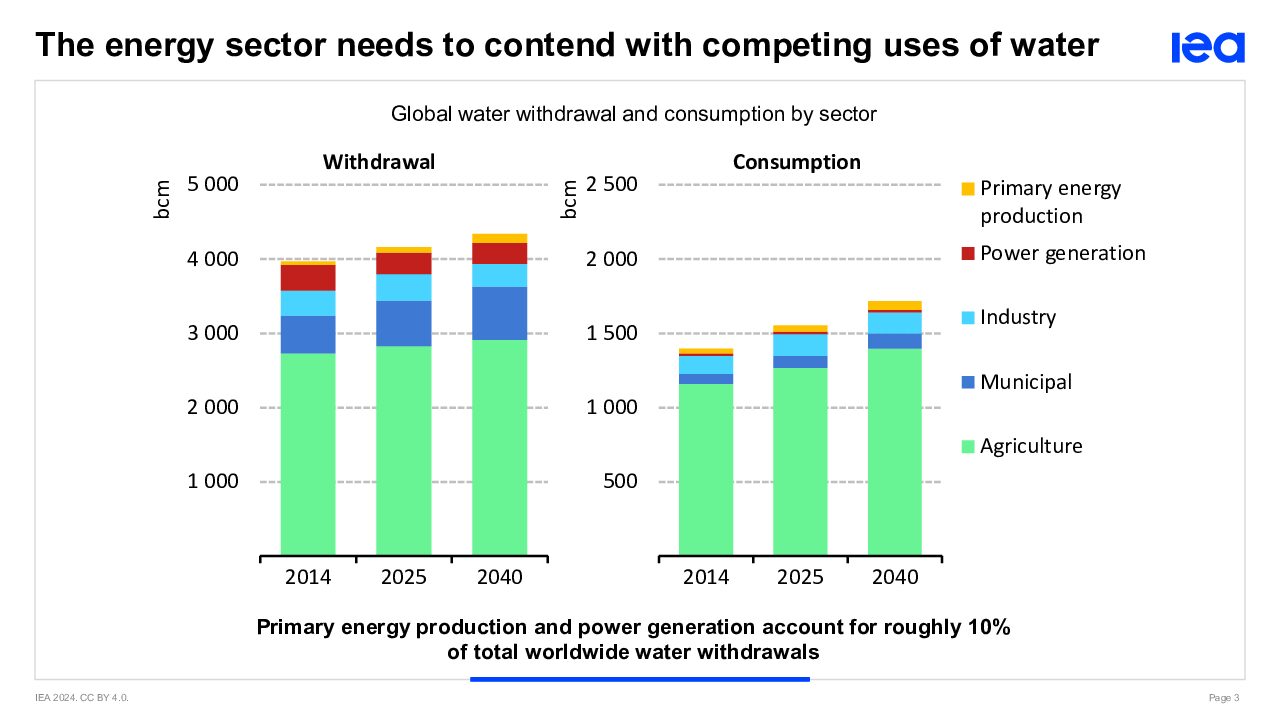
Water is vital at many stages of energy production and conversion. Gas requires water for drilling, cooling, and processing. Coal mining also needs water for crushing, dust control, and cleaning. Thermal power plants (including nuclear) need large volumes of water for cooling. According to Tomás Bredariol, energy and environmental policy analyst at the International Energy Agency (IEA), “some cooling technologies may withdraw a lot of water but return it, thus reducing net consumption, while others may withdraw less but entail significant evaporation and so increase consumption.”
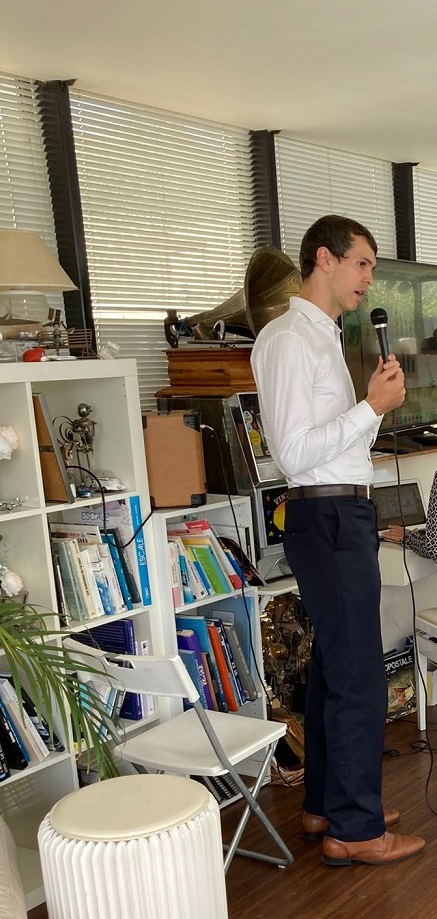
Some energy sources are inherently less water intensive. “Solar photovoltaic (PV) and wind power, for instance, are among the types of energy that use the least water,” confirms Mr Bredariol. “Based on current trends, their growth is contributing to a slight reduction in water consumption in the energy sector.” However, not all low-carbon technologies are water-efficient. “If we take the example of carbon capture and storage, this generally implies an increase in the water needs of the energy sector.”
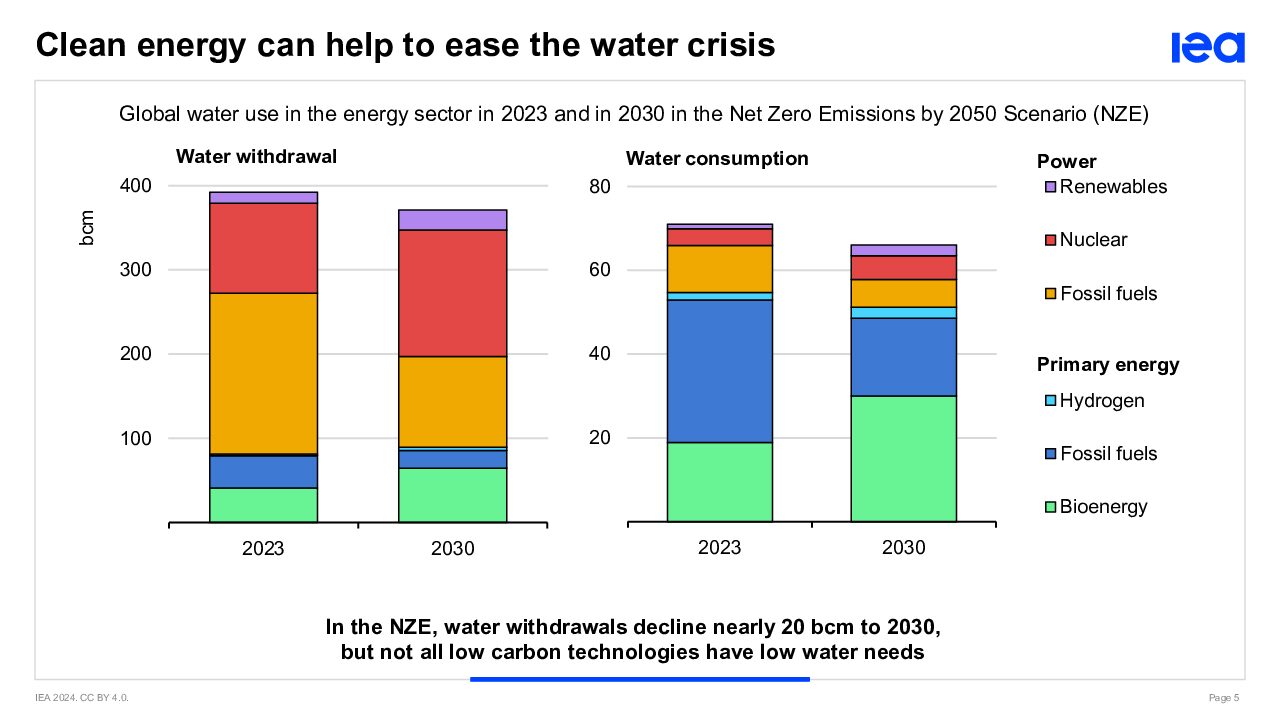
Water is a vital component of hydrogen production and is also used by its cooling systems. “In the IEA’s Net Zero Emissions by 2050 (NZE) scenario, aligned with the Paris Agreement, water use for biofuel and hydrogen production increases… but the sharp decline in fossil fuel use leads to an overall reduction in water withdrawals and consumption,” explains Mr. Bredariol.
Energy and water: an intimate relationship
A lot of energy infrastructure is vulnerable to flooding and drought, “also sometimes in unexpected ways,” adds Mr Bredariol. For instance, cooling thermal power plants doesn’t depend solely on volumes of water, but on their temperature too.
On the other hand, a considerable amount of energy is required to extract, treat, and supply water to society. Desalination plants, which provide an alternative source of water in regions where it is scarce (e.g. the Middle East, the United States, China…), are especially energy-intensive.
There are many ways to reduce pressure on water resources. For example, choosing technologies that use less water, or using lower-quality water (recycled, rainwater, or brackish water) for tasks like cooling and cleaning. Controlling operating systems more efficiently can reduce contamination by discharged water, which can be used for other purposes.
Better understanding the impact of lithium extraction on freshwater resources
Vast quantities of water are also needed to produce lithium and other critical metals used in batteries and for technologies supporting the production of clean energy (wind turbines, electricity grids, etc). Today in Chile, in order to mitigate the water stress caused by such extraction, copper mines must first secure their freshwater source, often through desalination, before obtaining authorisation to operate. These actions can sometimes also benefit local communities.
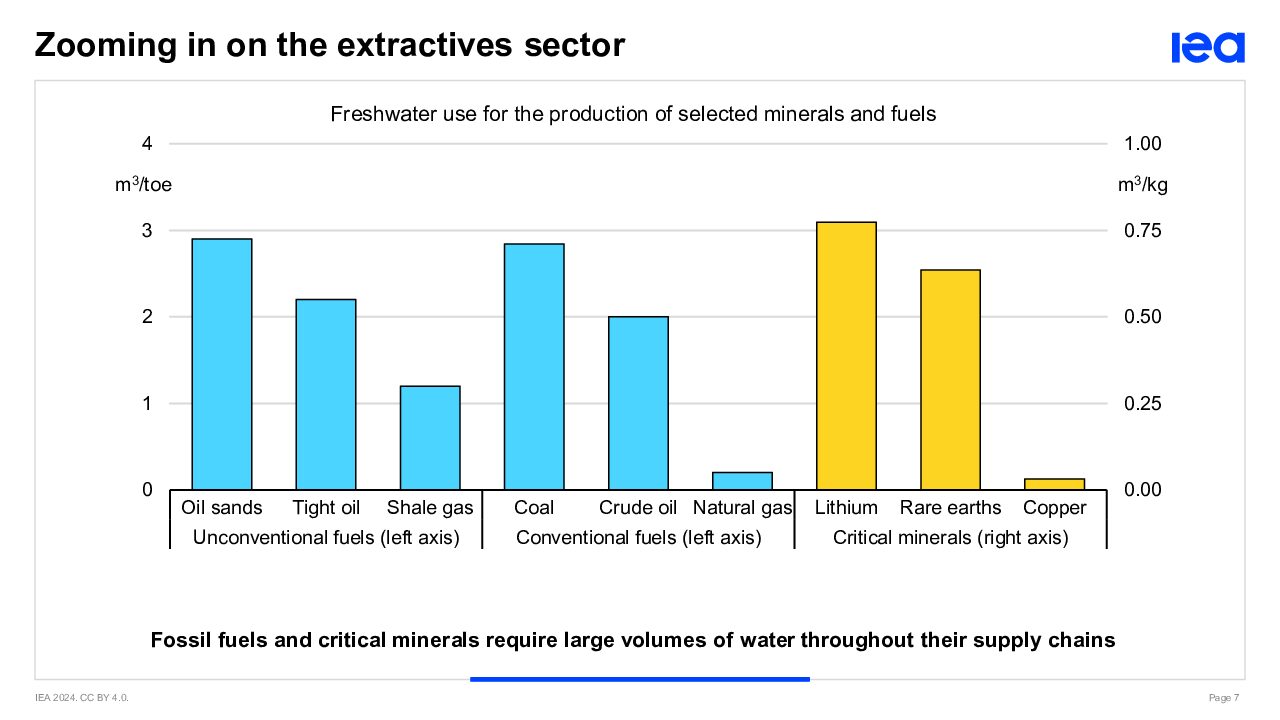
“There is much debate over extracting lithium, as well as other critical minerals like cobalt, nickel, and graphite, because of its environmental and social impacts, especially on water resources,” says Dr David F. Boutt, professor at University of Massachusetts-Amherst, hydrologist and co-author of the research paper ‘The hydrogeology of critical mineral resources relevant to the energy transition’ (2025). A debate that is hotting up today because demand for lithium, which far exceeds current supply, is growing and leading to a significant increase in extraction needs (see ‘Energy transition challenges for mobility’).
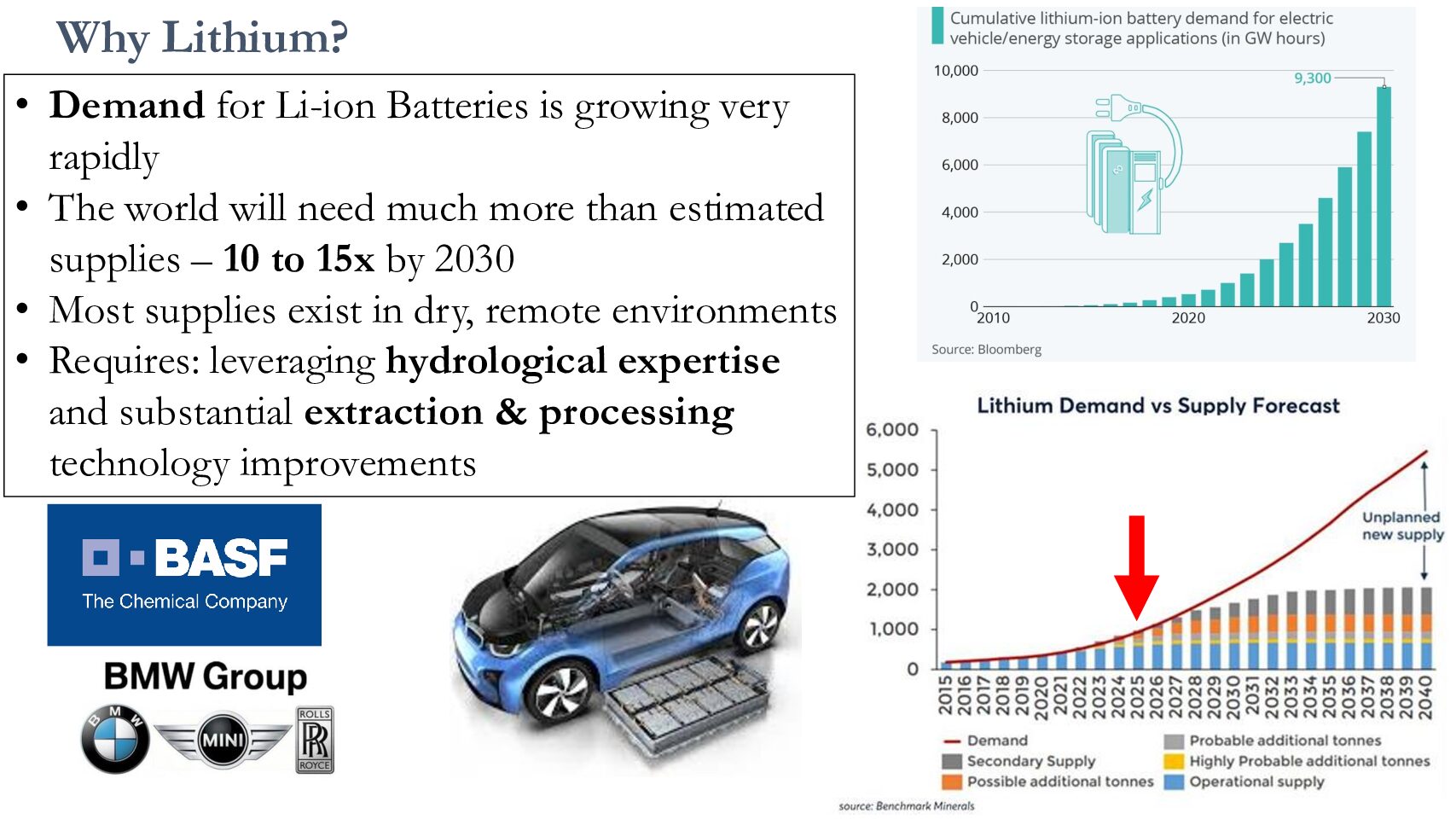
Lithium is extracted from different types of deposits with varying environmental footprints Approximately 60% of lithium comes from brines, around 30% from hard rock deposits (pegmatites), and — more recently — from clays.
Worldwide, brines are generally to be found in arid and extremely dry areas, like the ‘lithium triangle’ in South America: located at the meeting points between Chile, Bolivia, and Argentina, this volcanic region has closed basins, i.e., where water does not flow into the ocean. Approximately 60 to 70% of the world’s lithium from brines is extracted here. Over time, the water in the basins has evaporated, creating brines with high concentrations of lithium.
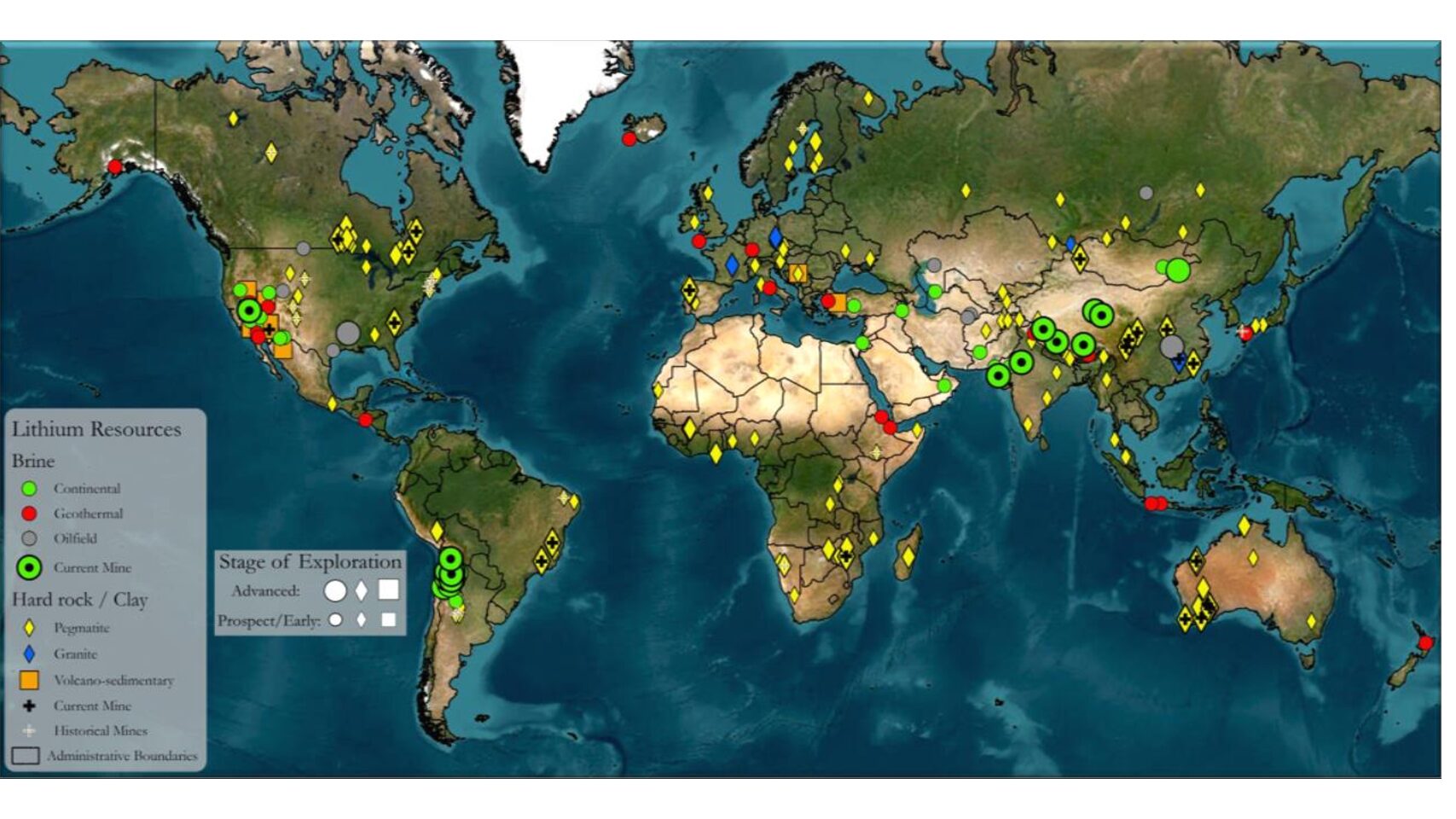
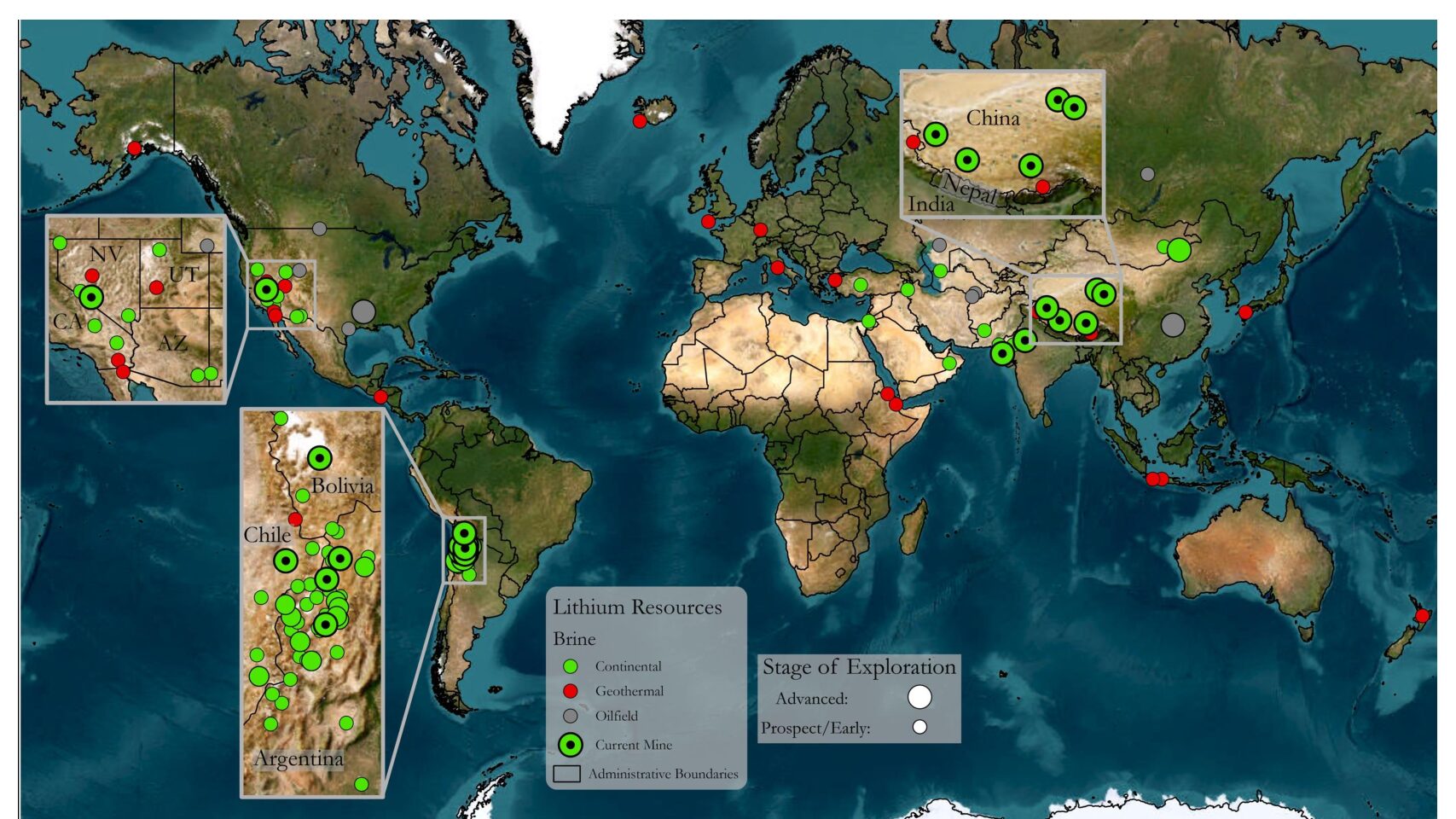
“The way these deposits form over time has a significant impact on their environmental sensitivity and on the water needed to extract these resources,” explains professor Boutt. There are essentially three components to the water footprint of lithium extraction:
– using freshwater flowing into the brine catchment area, competing with the needs of local inhabitants;
– removing the brine itself: although salty and generally unsuitable for drinking or agriculture, it plays a key ecological role by providing important ecosystem services, e.g. for pink flamingos;
– changes in the quantities of surface or groundwater available in these extremely dry areas may have an impact on ecosystems and humans, in the medium term.
Advances in technology are also a cause for concern. “Some methods of direct lithium extraction [DLE], for instance, use far more fresh water, 100 to 200% more than brine pumping,” warns professor Boutt. Although potentially more efficient for extraction, this type of technology could exacerbate pressure on already limited freshwater resources (see Kirshen, A. B., Moran, B. J., Munk, L. A., Russo, A. A., McKnight, S. V., Jenckes, J., et al. (2025). Freshwater inflows to closed basins of the Andean plateau in Chile, Argentina, and Bolivia. Communications Earth & Environment, 6(1), 177. https://www.nature.com/articles/s43247-025-02130-6).
It turns out that the water used for extraction is often actually ‘fossil water’. Much of the freshwater evaporated during lithium extraction operations in these arid regions comes from precipitation that fell hundreds or even thousands (3,000 to 4,000) of years ago. This ‘fossil water’ is not replenished by today’s climate (less precipitation), thus rendering its use even more critical.
This ‘lithium triangle’ zone suffers from severe water stress, with annual rainfall of only 1 to 18 millimetres per year, compared to a global average of around 160 millimetres. The activities of many multinationals (Chinese, American, Chilean, Korean, and European) seeking lithium and other precious minerals are only heightening this stress. Furthermore, “it is alarming to note how some global hydrological models overestimate rainfall and water availability in these regions, sometimes by a factor of one hundred to one thousand, meaning the situation is even more serious than generally perceived,” says a concerned professor Boutt.
“We need to rethink our approach to water in relation to the impacts of mining activities,” he concludes. “We must improve our knowledge, integrating it into more holistic environmental impact assessments, in order to guide more informed choices on the use and management of freshwater in these key regions for the energy transition.”
❓ What solutions can be implemented to limit the impact and vulnerability of the transport sector with regards freshwater resources?
Météo France forecasts ten times more heatwaves in France by 2100, together with more intense and less frequent rainfall that will significantly increase the risk of urban flooding. These climatic phenomena are putting a strain on transport infrastructure, which must adapt to remain operational and sustainable.
Faced with these challenges, Colas – a subsidiary of the Bouygues Group specialising in the construction and maintenance of transport infrastructure – has developed StreetADAPT, an innovative and scalable approach to making cities more resilient.
This approach focuses on urban planning, especially in response to overheating and flooding. Its objective with regards water is to slow down flow, prevent rapid accumulation, and maximise infiltration or retention of ‘every single drop’ of rain.
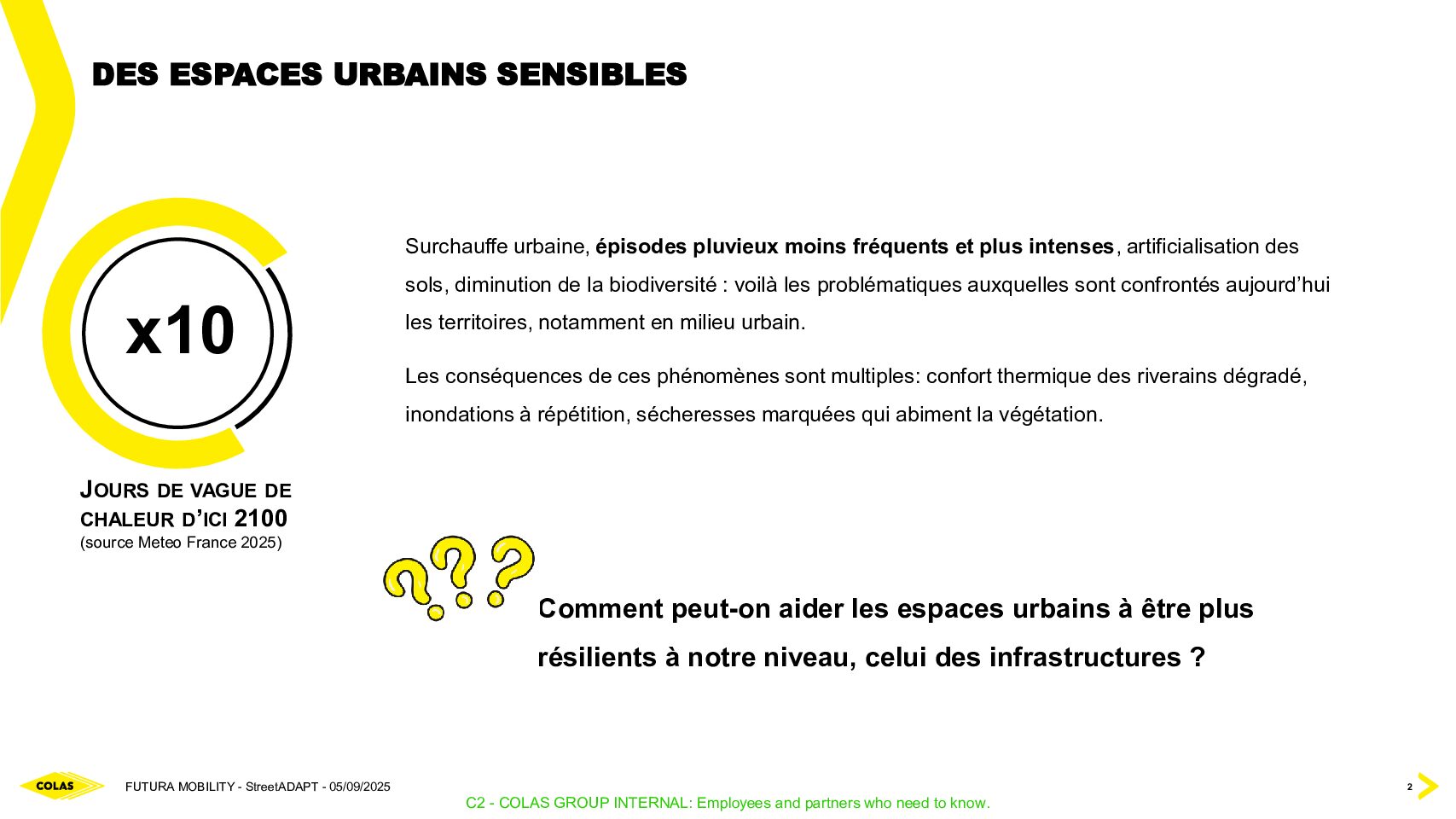
“To adapt public spaces, we focus on an adapted albedo, permeable soils and surfaces, optimised water management, vegetation and shade,” explains Véronique Picard-Kapucu, head of Smart Infrastructure at Colas.
Each project is designed according to its local context, taking into account the region, impermeability of the site and, above all, the subsoil. “We also draw on our in-house expertise at Colas, with measuring stations, microclimate modelling, and urban ecological engineering, to offer truly tailor-made solutions,” adds Ms Picard-Kapucu.
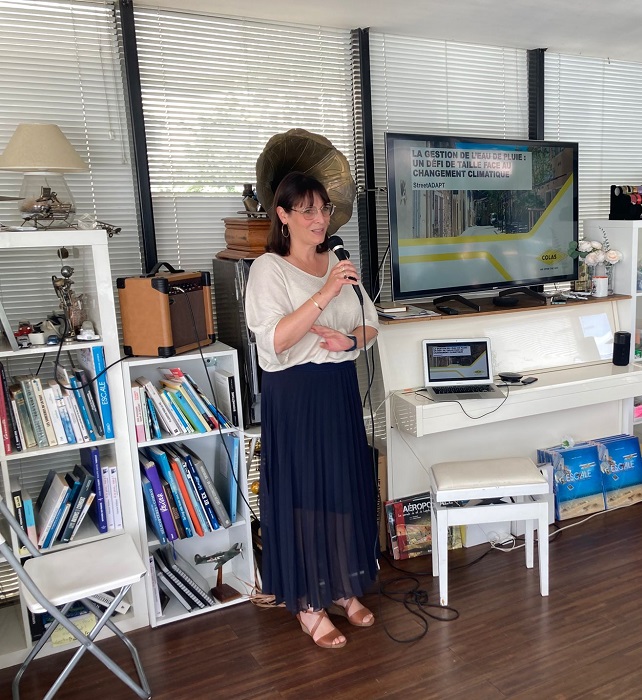
This innovative approach is based on the principle of capturing water through permeable surfaces with storage or infiltration solutions beneath, depending on the specific characteristics of the project: “the choice between direct infiltration or storage depends on local objectives and available space, on whether the developer wants permanent green spaces or simply to slow down water flow to prevent flooding,” explains Ms Picard-Kapucu. The water can then be reused for vegetation in planters, thereby promoting shade. “We also aim to limit the phenomenon of rapid rainwater concentration and pipe saturation, in order to simplify network maintenance for municipalities and also enable them to recover as much water as possible for watering and maintenance throughout the city.”
Among StreetADAPT’s outputs is a pedestrian area in Nevers, redesigned with grass pavers that allow water to infiltrate more easily, with another part being recovered to supply a water feature. In Ramatuelle, in the Provence-Alpes-Côte d’Azur region, where average temperatures are rising year on year, water recovered is used to water trees that will help regulate temperatures.
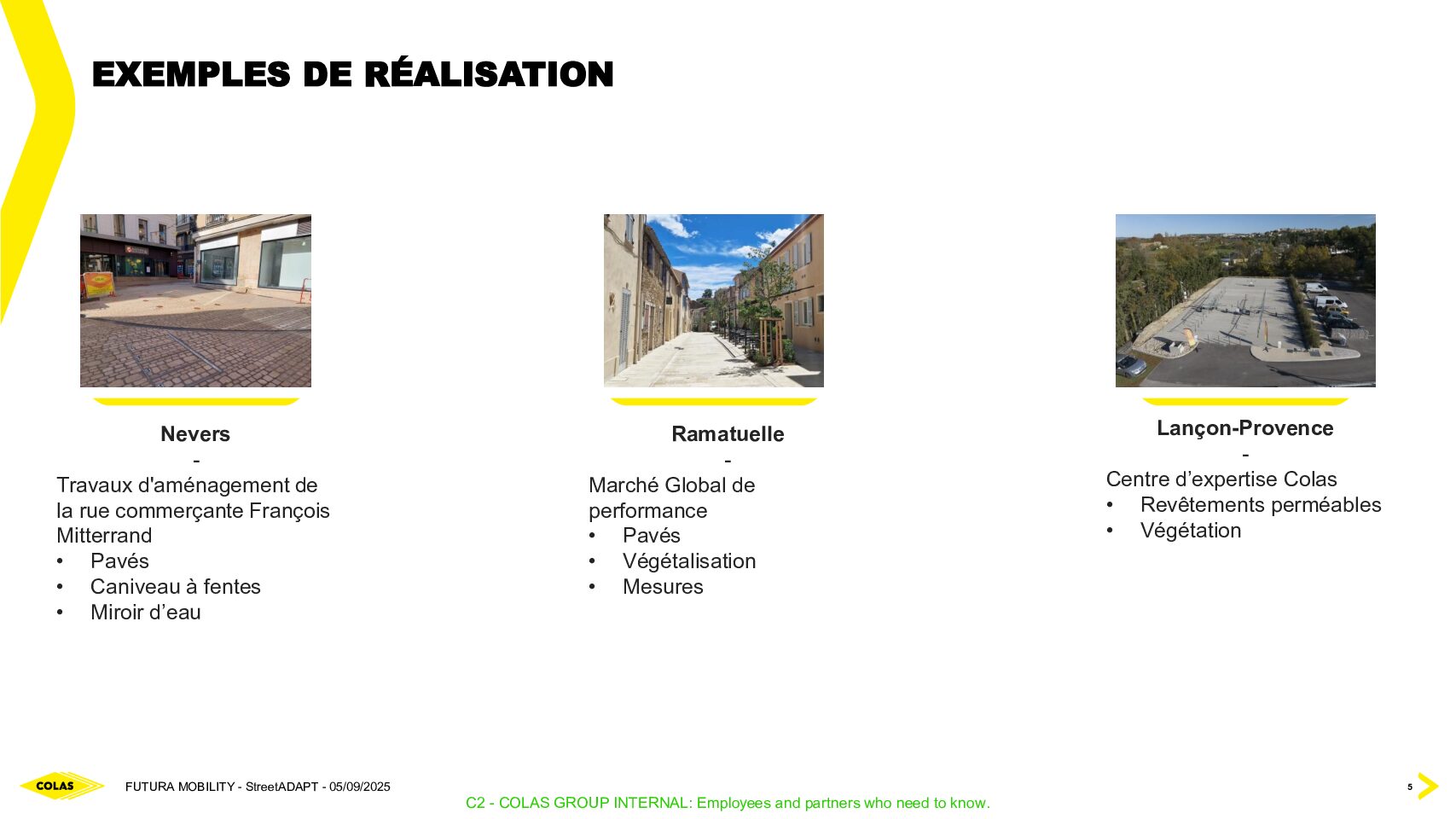
A demonstrator in Marseille, part of the Smartport Challenge 2024, also showcases the StreeADAPT solution: water collected by a permeable asphalt structure is used to supply planters near the ferry arrivals, thereby making the area more attractive. “The aim is to see whether this demo can be used to develop all the areas around ferry arrivals, to make them more pleasant with vegetation and permanent green spaces,” explains Ms Picard-Kapucu.
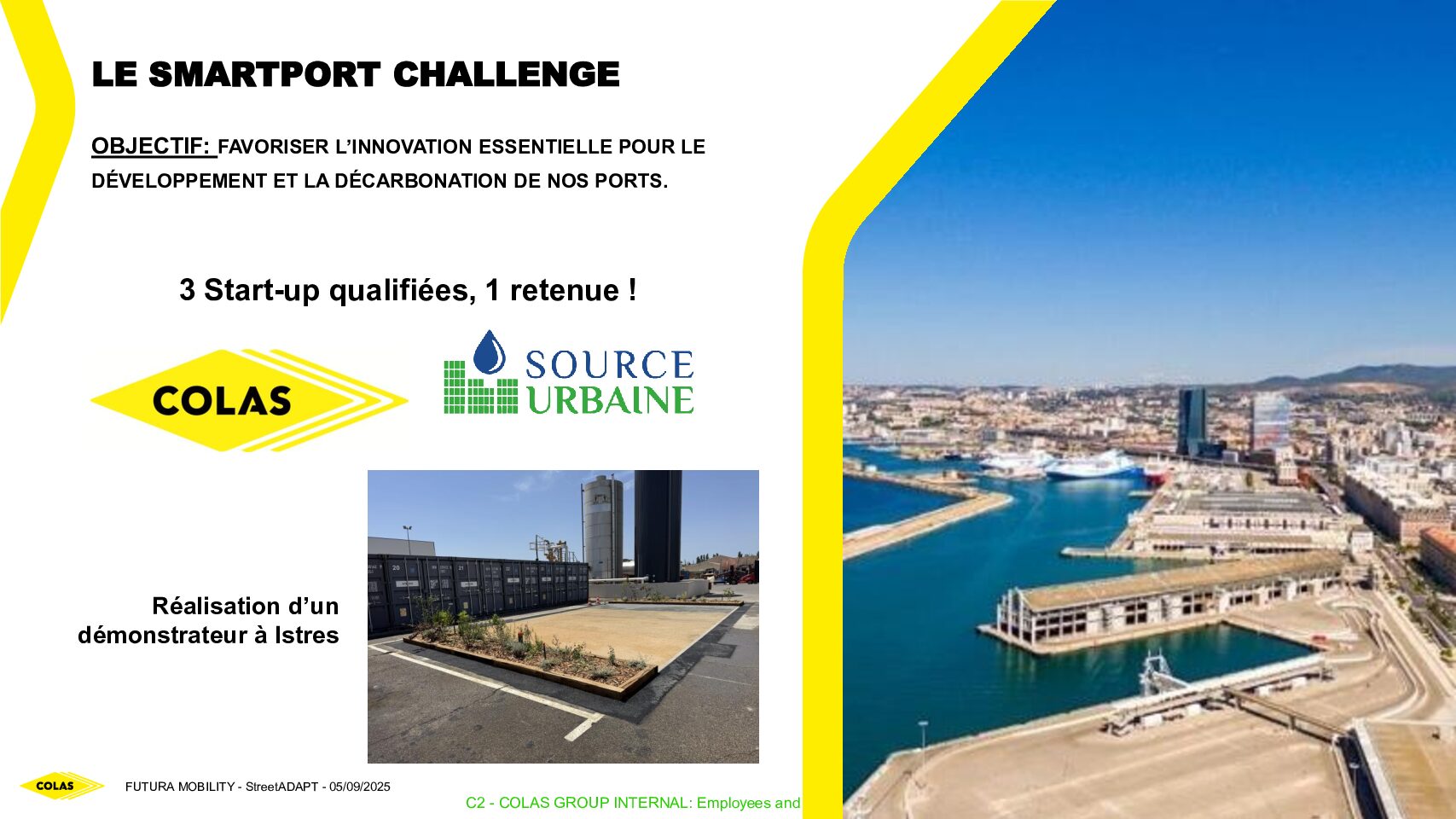
Colas also has an expertise centre in Lançon-Provence, which serves as a laboratory for better understanding the behaviour of water in its claddings. The company is also actively involved in national groups and projects to promote acceptance of these new solutions among clients. “As a company, we are dependent on everything related to project management. We can propose innovative developments, but urban planners can of course reject them,” says Véronique Picard-Kapucu. “With solutions like StreetADAPT, it’s a question of changing the way we look at things, shifting from current water recovery systems, designed for exceptional rainfall, to daily recovery of light rainfall by integrating this approach from the design phase of projects.”
Issues related to water resources: the SNCF experience
Like Colas, SNCF Group is developing its expertise and exploring ways to address the challenges of freshwater resource management.
For its rail activities, the company uses freshwater mainly for train maintenance and washing, track maintenance and repairs, green spaces and cleaning (service vehicles, stations, office premises, etc), drinking and sanitary water (for employees and customers in stations, services, shops, etc), and firefighting (to protect the areas surrounding rail tracks). With global warming and longer periods of drought, the availability of water resources is a becoming a growing concern.
“There is a significant industrial risk at SNCF, given the many train maintenance operations directly linked to water,” explains Aurélie de Salinelles, project manager at SNCF Voyageurs and contracting lead for the management of TGV industrial operations. “Water restrictions or pollution could lead to production difficulties or, in the case of pollution, the closure of a site or a ban on discharge following our operations.” At the same time, the legal framework governing water is becoming stricter, with more controls and compliance requirements – “which is a very good thing, but creates associated litigation risks.” Finally, there is an economic and financial risk, although the direct cost of water for SNCF Group – around 22 million euros annually compared to 600 million for energy – is not an immediate trigger for driving behaviour change.
“Indeed, despite a real awareness and identification of risks within the Group, setting up steering bodies for water resources is complex. This is undoubtedly linked to this absence of price signals and also difficulties in obtaining accurate data on water consumption and usage,” acknowledges Ms de Salinelles.
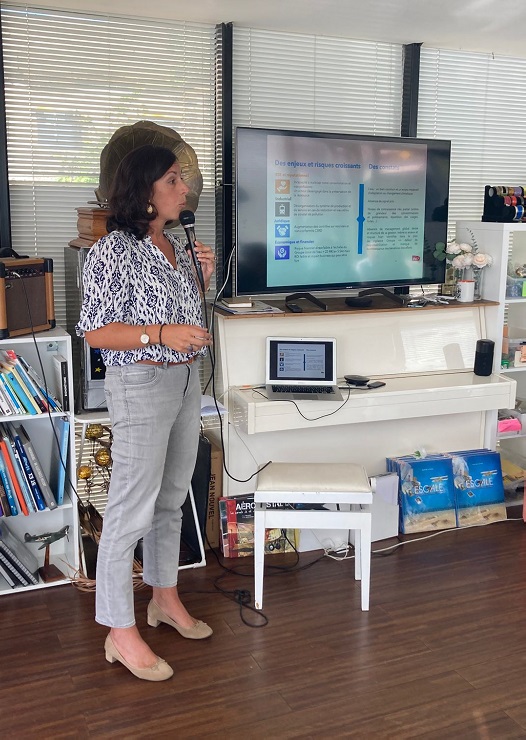
All together
The common framework agreed in 2023 by five public limited companies (SA) owned by SNCF Group (SNCF Direction Générale, SNCF Réseau, Rail Logistique Europe, SNCF Gares & Connexions, and SNCF Voyageurs) includes a short-term water conservation plan with targets reviewed annually. Since April 2025, this framework now includes a medium- and long-term water conservation policy, structured around four key areas:
- Water conservation and the circular economy, especially by treating rain and grey water to minimise water withdrawals from the network.
- Preparing for periods of drought, since operations are highly dependent on water.
- Reducing the impact of discharged water on aquatic environments.
- Controlling impacts on the quality of water resources.
“One of our key quantitative commitments is to reduce the consumption of drinking water by 10% by 2030 and by 25% by 2035 for the sites with the highest consumption,” underlines Ms de Salinelles. “This commitment directly concerns SNCF Voyageurs’ technical centres.”
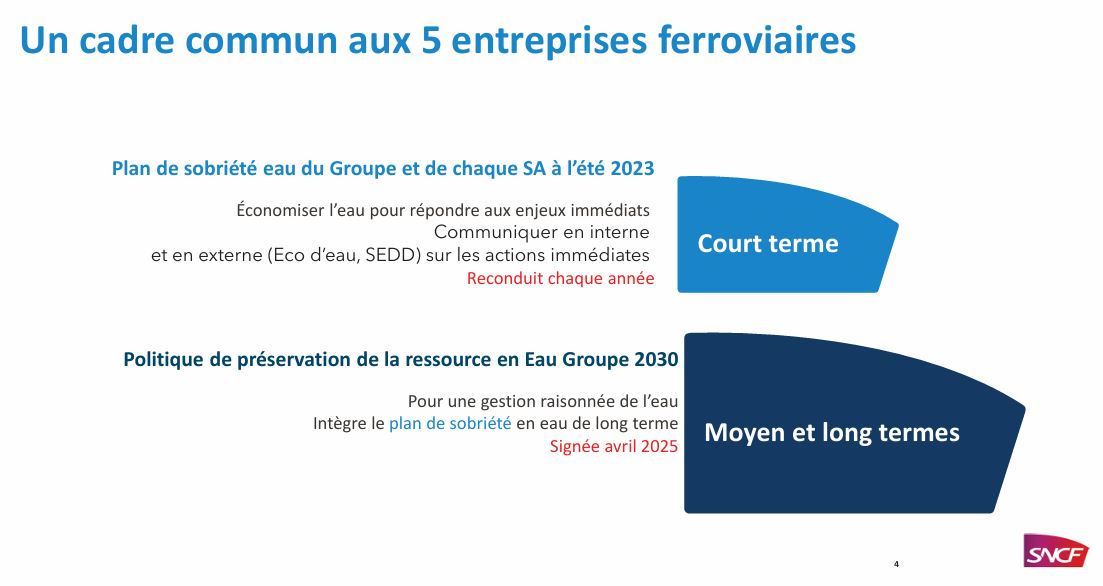
Exterior train cleaning: towards new horizons
“Train cleaning is quite a symbolic operation for SNCF,” explains Ms de Salinelles, who manages the train cleaning master plan. It is an operation directly affected by water restrictions: prefectural decrees prohibit exterior train cleaning once an alert level is reached, which can impact SNCF technical centres for up to three to four months a year in some geographical areas. At the same time, the cleanliness of trains is highly visible to customers and associated with brand image – “an aspect that is all the more important with the opening up of the sector to competition,” adds Ms de Salinelles. “And, paradoxically, a clean train in summer can raise suspicions of excessive water consumption, which goes against the Group’s commitments.”
Complex indeed, yet an opportunity for SNCF to thoroughly re-evaluate the situation. The train cleaning master plan, approved in May 2025, aims in particular to avoid manual cleaning, a difficult and costly task, and control the overall costs of cleaning operations. These two objectives are based on three focus areas:
- Offer more cleaning opportunities, in particular by finding postponement solutions for trains that cannot be cleaned locally due to restrictions.
- Reuse and adapt existing facilities (rather than build new) to make them more resilient and efficient.
- Limit water consumption and improve facilities by recycling water and using rainwater to avoid withdrawals from the network during restricted periods.
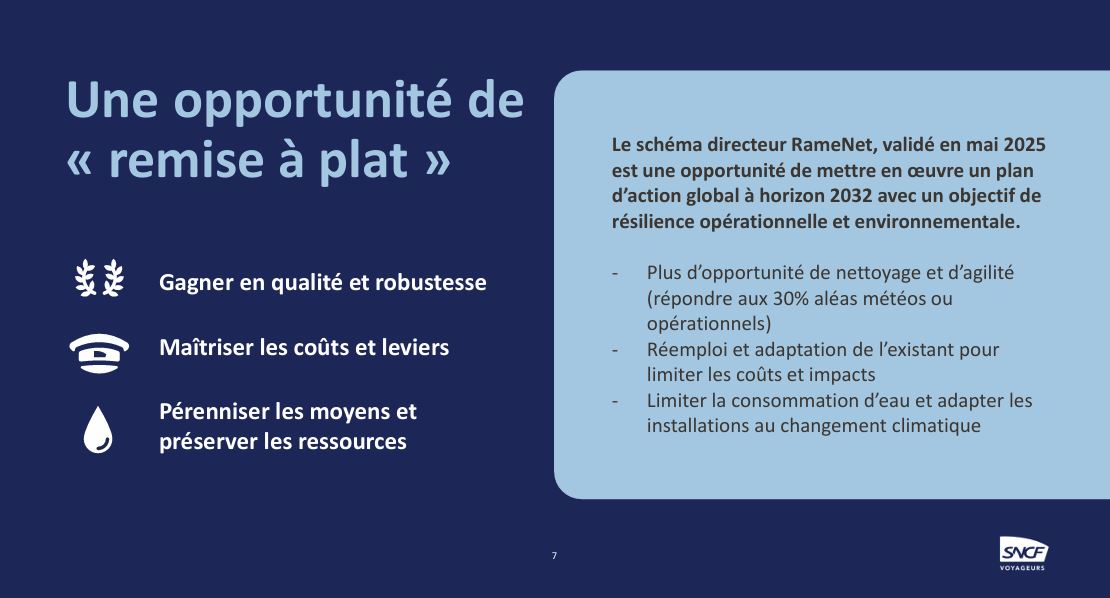
This action plan calls for a re-evaluation of cleaning techniques. Closed washing tunnels are extremely efficient and recycle water in a closed circuit, but are expensive and not easy to adapt to existing infrastructure in France. “They are widely used in Germany, Luxembourg, and Switzerland, because their integration is planned from the outset when technical centres are built,” explains Ms de Salinelles. With fixed outdoor equipment, generally used by SNCF throughout France, wastewater can be partially recycled and treated. The company is looking to give up manual cleaning, still used in France and especially in Spain, since it consumes a lot of water and puts physical strain on workers. Finally, mobile cleaning, widely used in Italy and currently being tested at one of SNCF’s technical centres, “offers greater flexibility and improved performance with regards water treatment and recycling.”
The rail operator is also working with manufacturers to study using rainwater, whose highly acidic pH means washing systems need to be adapted. Wastewater treatment is another area of study. A dry cleaning project that does not use water, also in development, could revolutionise the approach to cleaning trains.
“We are gradually becoming aware of our impact and vulnerability to freshwater resources,” sums up Aurélie de Salinelles. “And after taking part in today’s Futura-Mobility session, we can say that we need to speed up more!”
Innovation for micro-mobility
Closing this Futura-Mobility session, on the sidelines of these presentations on water, Étienne Sana, CEO of Mooviatec, introduced a mobility innovation. Futura-Mobility is also keen to spotlight solutions that increase societal benefits.
The young company markets segways with gyrostabilisation technology initially designed for a wheelchair capable of mounting stairs.
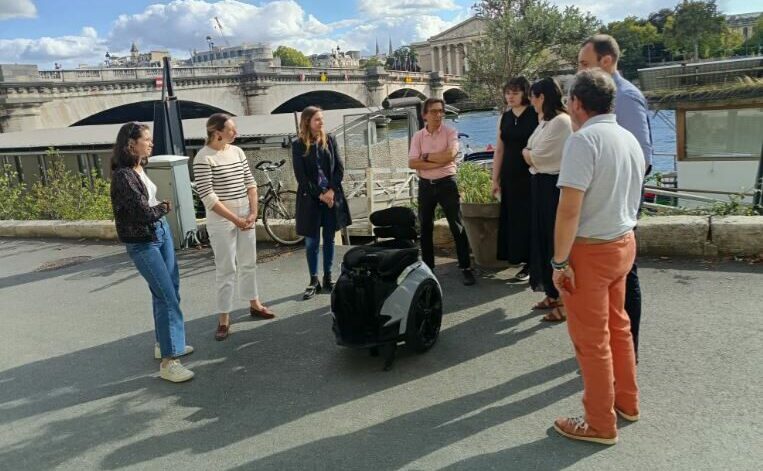

These chairs, controlled by tilting the body, are a means of active mobility for people with reduced mobility. Users can adjust their height and negotiate steps and ramps. Mooviatec also proposes them as urban micromobility solutions for replacing a car in the city, with a speed of 20km/hr and 30km range. An extremely promising innovation to watch out for!



